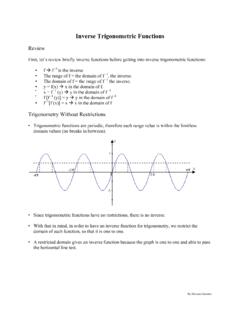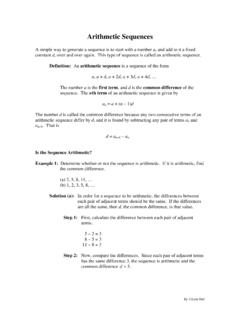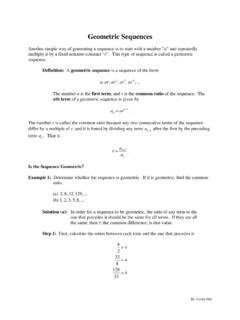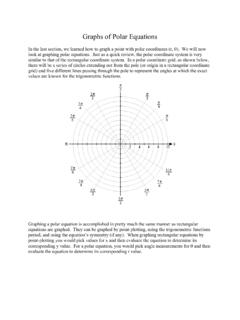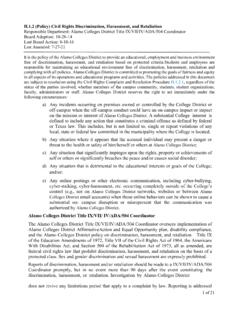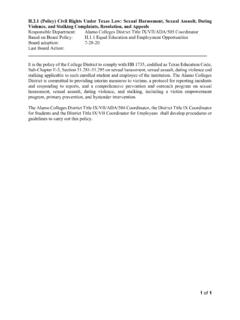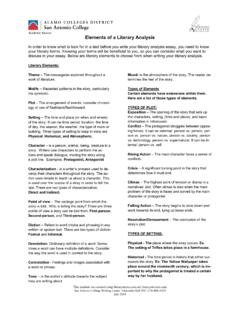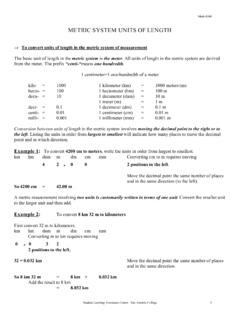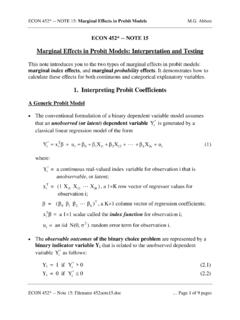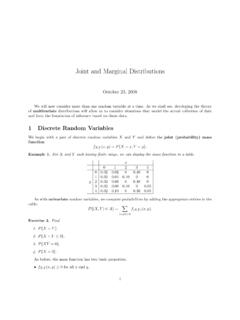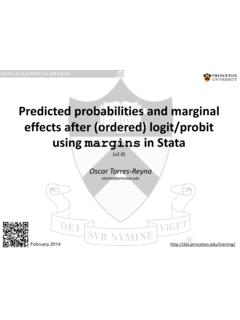Transcription of Marginal Functions in Economics - Alamo Colleges District
1 Marginal Functions in Economics One of the applications of derivatives in a real world situation is in the area of Marginal analysis. Marginal analysis uses the derivative (or rate of change) to determine the rate at which a particular quantity is increasing or decreasing. In this section, the Marginal Functions that we will cover are those for the cost, average cost, revenue, and profit Functions . The last topic that will be covered is the elasticity of demand. No matter which function we are dealing with, the word Marginal indicates to us that we need to find the derivative of the function. For example, if we are asked to find the Marginal cost function then we need to find the derivative of the cost function. When the Marginal function is evaluated it will give the approximate change for the next unit. For example, if we evaluated a Marginal cost function when x = 100 then the value of C (100) would be the approximate cost of producing the next unit (or the 101st unit).
2 Example 1: If a company s total cost function is defined as C(x) = + 400x + 50000, find the Marginal cost function and evaluate it when x = 200. Solution: Find the first derivative of the cost function C(x) = + 400x + 5000 C (x) = + 400 Substitute the given value for x into the Marginal cost function C (x) = + 400 C (200) = (200)2 (200) + 400 C (200) = (40000) (200) + 400 C (200) = 8 + 400 C (200) = The approximate cost of producing the 201st unit will be $ The next function that you may be asked to find is the average cost function. The average cost function is determined in the same manner that you would find an average. We want to divide the total production cost, C(x), by the total number of units, x. The average cost function is distinguished from the cost function with a bar above the function notation, ()Cx.
3 Average cost ()Cx = ()Cxx The Marginal average cost function would then be obtained by taking the first derivative of the average cost function. Gerald ManahanSLAC, San Antonio college , 20081 Example 2: Using the same cost function from Exercise 1, C(x) = + 400x + 50000, find the Marginal average cost when x = 200. Solution: First, we need to find the average cost function ()Cx = ()Cxx ()Cx = ++ ()Cx = + 400 + 50000x Next, find the Marginal average cost function by taking the 1st derivative of ()Cx ()Cx = + 400 + 50000x ()Cx = + 400 + 50000x-1 ()Cx = + 0 50000x-2 ()Cx = 250000x Now, evaluate the Marginal average cost function when x = 200 ()Cx = 250000x (200)C = (200) 250000(200) (200)C = 5000040000 (200)C = (200)C = The process of finding the Marginal revenue and Marginal profit function is the same as how we found the Marginal cost function.
4 The only difference that you may encounter is the need to first determine the revenue or profit Functions . If the revenue function is not given, then it will be equal to the price per unit (p) times the number of items sold (x). R(x) = px Gerald ManahanSLAC, San Antonio college , 20082 The profit function is the difference between the revenue and cost Functions . P(x) = R(x) C(x) Example 3: Suppose the relationship between the unit price p in dollars and the quantity demanded x is given by the equation p = + 750 where 0 x 25,000. Find and interpret R (3000). Solution First, find the revenue function R(x) = px R(x) = ( + 750)(x) R(x) = + 750x Next, find the Marginal revenue function R(x) = + 750x R (x) = + 750 Now, evaluate the Marginal revenue function when x = 3000 R (x) = + 750 R (3000) = (3000) + 750 R (3000) = 180 + 750 R (3000) = 570 The sale of the 3001st unit would produce revenue of approximately $570.
5 Example 4: Suppose a company s weekly demand for their product is p = 500 where p is the unit price in dollars and x is the quantity demanded which must be between 0 and 12000. The cost function is given by C(x) = + 300x + 78000. Find P (2500) and interpret the results. Solution First, we need to find the revenue function R(x) = px R(x) = (500 )(x) R(x) = 500x Gerald ManahanSLAC, San Antonio college , 20083 Example 4 (Continued): Next, find the profit function P(x) = R(x) C(x) P(x) = (500x ) ( + 300x + 78000) P(x) = 500x + 300x 78000 P(x) = + 200x 78000 Now, find the Marginal profit function P(x) = + 200x 78000 P (x) = + 200 Last, evaluate the Marginal profit function when x = 2500 P (x) = + 200 P (2500) = (2500)2 (2500) + 200 P (2500) = (6250000) (2500) + 200 P (2500) = 375 100 + 200 P (2500) = 275 The sale of the 2501st unit would result in a loss of approximately $275.
6 The last topic for this section of notes is the elasticity of demand. The elasticity of demand represents a ratio of the percentage change in quantity demanded to the percentage change in the unit price. E(p) = ()()pfpfp There are three possible cases for the elasticity of demand: 1. Elastic when E(p) > 1 A small percentage change in unit price will result in a larger percentage change in quantity demanded. Revenue is decreasing on an interval where the demand is elastic. 2. Unitary when E(p) = 1 A small percentage change in unit price will result in the same percentage change in quantity demanded. Revenue is constant at the point where the demand is unitary. Gerald ManahanSLAC, San Antonio college , 200843. Inelastic when E(p) < 1 A small percentage change in unit price will result in a smaller percentage change in quantity demanded.
7 Revenue is increasing on an interval where the demand is inelastic. Example 5: Compute the elasticity of demand for the demand equation, 4x + 5p = 80, and determine whether the demand is elastic, unitary, or inelastic when the price is $10. Solution Solve the demand equation in terms of x 4x + 5p = 80 4x = -5p + 80 x = -54p + 20 let f(p) = x f(p) = -54p + 20 Find the derivative of the demand function f(p) f(p) = -54p + 20 f (p) = -54 Find the elasticity of demand E(p) = ()()pfpfp E(p) = 5454()20pp + E(p) = 5454()20pp +* 44 E(p) = 5580pp + Gerald ManahanSLAC, San Antonio college , 20085 Exercise 5 (Continued): E(p) = 16pp Evaluate the elasticity of demand when p = 10 E(p) = 16pp E(10) = 1010 16 E(10) = 106 E(10) = -53 Since the elasticity of demand is < 1, the demand is inelastic when p = 10.
8 Gerald ManahanSLAC, San Antonio college , 20086

